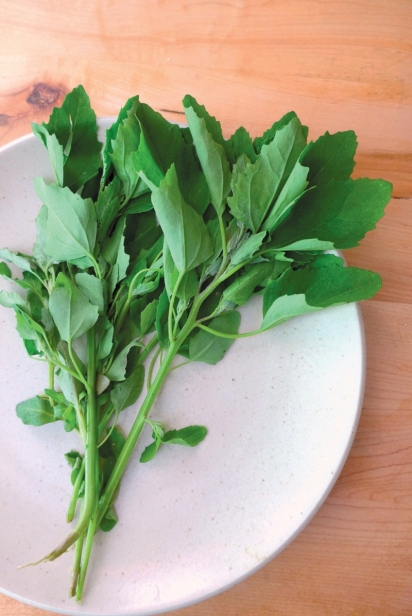Eating Wild
Abundant and Versatile Lamb’s Quarters
There are really no two ways about it: if you like spinach, you’ll like lamb’s quarters.
It would be difficult to walk around the Cape’s green spaces without finding large stands of this wild edible plant lining roadsides and trails among the dandelions and raspberry brambles. Prolific in much of the northeastern United States, lamb’s quarters first caught my eye while I was working on Cape Cod farms years ago. I was just discovering the world of foraging, and as with many edible plants that we often call weeds, lamb’s quarters loves disturbed soil. This means that it often shows its face right where it is less than welcome—in cultivated garden rows. Luckily, lamb’s quarters is a useful and highly nutritious food in its own right, worthy of saving from the compost pile as you pluck the plant from around your garden beds.
Lamb’s quarters’ mild flavor, culinary versatility and fairly simple identifying characteristics make it a great plant for those interested in harvesting their own wild food. Though all foraging requires careful and thorough research to insure positive plant identification— especially when you are just starting out—there are some key features to look out for in lamb’s quarters.
Lamb’s quarters’ alternate (or slightly staggered) leaves have a distinctive, loosely triangular shape with toothed edges, reminiscent of a goose’s foot, which is one of the plant’s common names. They have an often-grooved stem that is tender and edible when the plant is young and becomes tough on older plants. Much of the plant is covered in a waxy white powder that can be rubbed off on your fingers. This waxy residue, found particularly on the undersides of young leaves, is one of the best ways to distinguish lamb’s quarters from plants with similar leaf shapes and growing patterns.
Since lamb’s quarters often grows near roads and yards, I find the only real hurdle in harvesting this wild green to be finding patches away from spaces that are likely to be treated with pesticides and fertilizers (or visited on a regular basis by our four-legged friends). And, as always when venturing into greenery on Cape Cod, remember to keep your eyes open for dreaded poison ivy, avoiding patches of lamb’s quarters that may have come into contact with that plant’s harmful oils.
The absolute abundance of lamb’s quarters throughout the growing season means it can make a real dent in both your cooking needs and in your produce budget. Another of lamb’s quarters many common names is wild spinach due to the similarity in flavor between the two plants, and this mild and delicious green can be prepared in any way one might use spinach.
I often use lamb’s quarters leaves in fresh salads and pasta dishes, pureed in soups and dips, and in egg dishes like omelets and quiche. While lamb’s quarters leaves are best used as a fresh green before the plant goes to seed, the plant continues to prove itself useful even after the tiny black seeds appear. Once harvested and after removing the chaff, those nutritious seeds can be added into baked goods like breakfast breads and muffins.
Years after first weeding out this goose-foot-shaped green from strawberry fields and asparagus rows, lamb’s quarters has become not only one of my favorite forageable plants, but one of the most useful wild greens in my kitchen. So while you may not want lamb’s quarters in all of your garden beds, leave some patches of this useful stowaway around your yard and enjoy a delicious green you didn’t have to grow.
*NOTE: Always consult with experts and refer to field guides for 100% positive plant identification before consuming any wild plant. As with any new food, integrate wild plants into your diet in small quantities to gauge any dietary sensitivities, and consult with a doctor if you have any questions or concerns about specific health issues or medication interactions.







